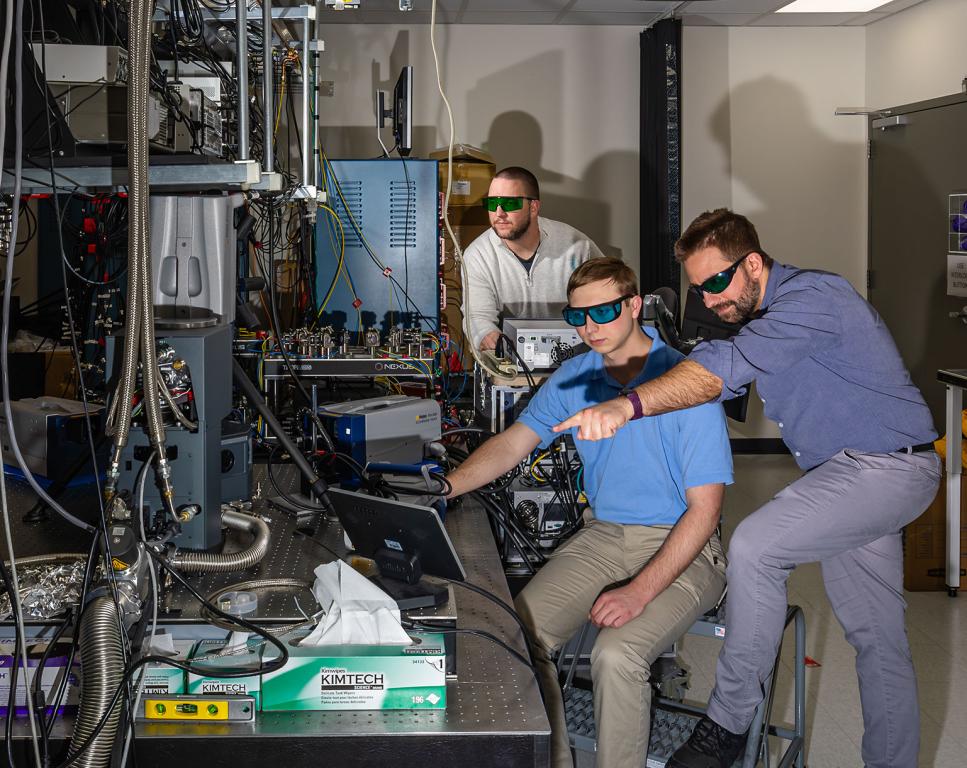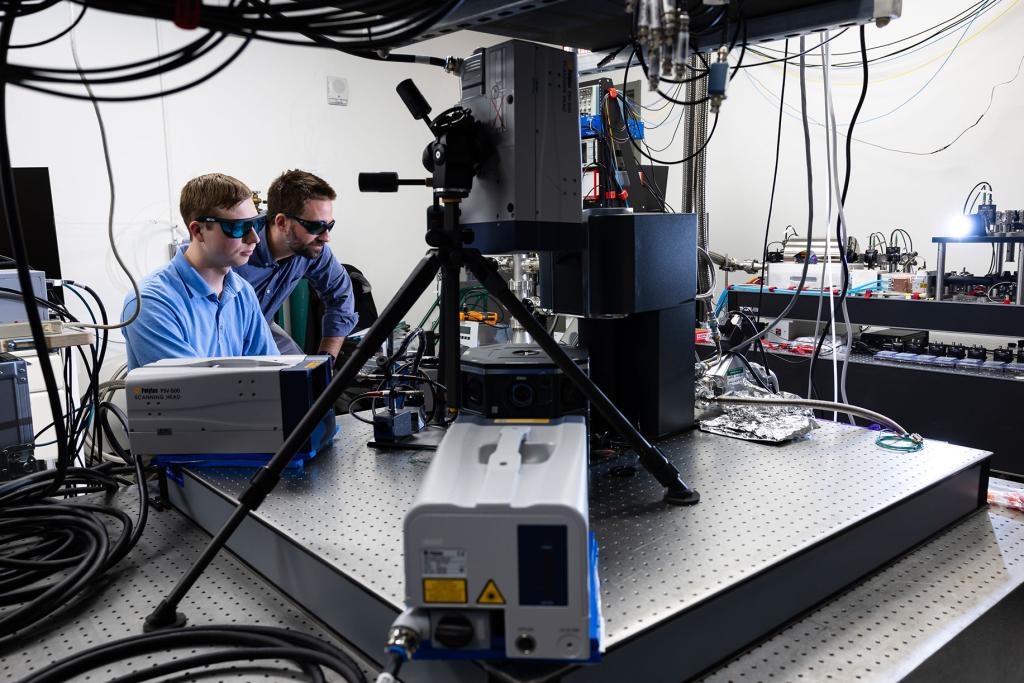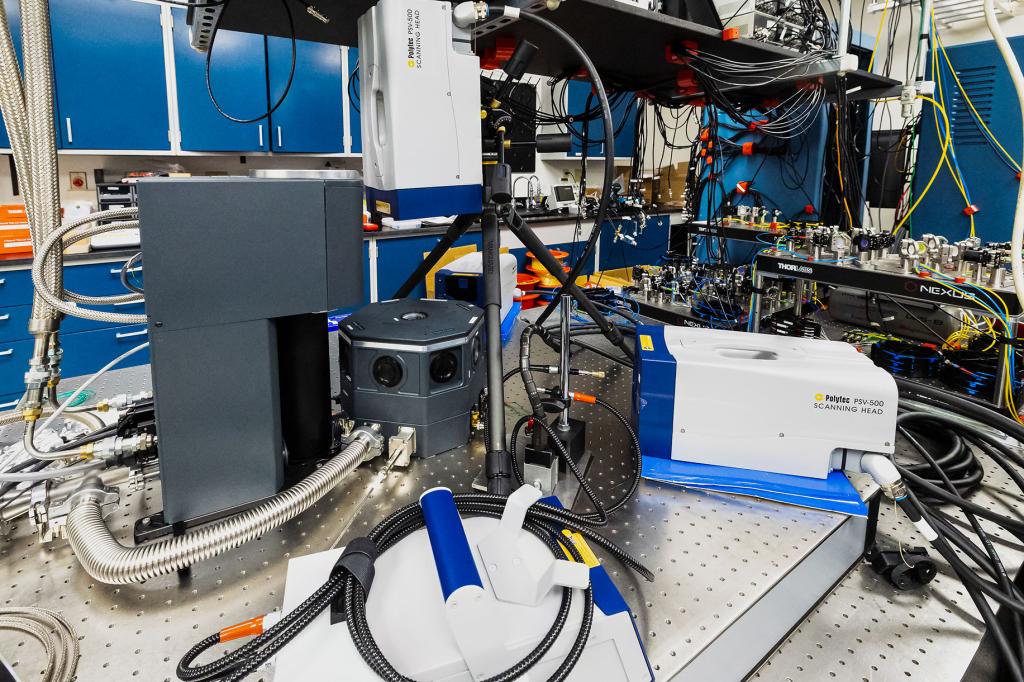
The last time this team used Oak Ridge National Laboratory's 3D scanning vibrometer, it was to measure a gigantic composite panel.
This time, they're measuring the vibration amplitudes of a cryogenic ion trap - around 10 nanometers, peak to peak.
"This is the first real test of the absolute limits of the machine," said researcher Blake Van Hoy of the Isotope Science and Engineering Directorate's Enrichment Science and Engineering Division, or ESED.
Van Hoy is the resident expert on the 3D scanning vibrometer. After he wrote a plant capital equipment proposal pitching it as a long-term infrastructure investment, the lab in 2021 purchased the specialized equipment, which uses visible or infrared lasers from three heads to build a geometric matrix, scattering light and assessing vibration to produce high-fidelity measurements of just about any object - enormous to tiny, any shape.
Its primary use at ORNL so far has been to help ESED with research and development. The composite panel, for example, was measured along with other types of panels to see which was best at reducing vibration energy.
But Van Hoy has advocated for more widespread use of the scanning vibrometer, which belongs to the lab, not specifically to ESED.
That's why he was excited to hear from Chris Seck, a research scientist in the Computing and Computational Sciences Directorate's Quantum Sensing and Computing group.

Seck is leading a project to engineer and develop a cryogenic ion trap apparatus to simulate quantum spin liquids, a key research area in materials science and neutron scattering studies. In the simulator, Seck can manipulate the trapped ion qubits - or quantum bits, the basic unit of information in quantum computing − to behave similarly to quantum materials that would be difficult to study in a lab.
But a common source of error in using cryogenic ion traps is the vibration of the actual apparatus, which factors into how the ions behave.
Seck is using a custom-built vacuum system inside a commercial cryo cooler to cool the apparatus, but he needs to be able to quantify the vibration of the mechanical cooler. When Seck read about the lab's laser scanning vibrometer, he thought it could be used to quantify the vibrations. Not only would that give him a baseline for his own research, it also could help with engineering of future systems to further reduce vibrations.
"But this is much smaller than what they're used to measuring," Seck said.
It's also different in other ways. For one, the team - which also includes ESED's Trevor Michelson and J.D. Rice − will shoot at the tiny target area through glass. And while often the three laser heads are pointed at a single target, to provide a 3D model, in this case each head will point to an individual measurement point.
"This is going to be an interesting experiment for us because it's pushing the absolute limits of everything we could think of to do," Van Hoy said. "It's going to be a good learning experience to know what the limits are."
Many of the exceedingly detailed measurements the system can perform were once attempted with accelerometers, expensive and fragile button-size sensors that were placed in multiple locations to measure vibration frequency and damping.

But in this case, that would never be an option, Michelson said, because the accelerometers would be too big to use in the small space, and their added weight would invalidate the experiment by changing the dynamic behavior of the ion trap and associated vacuum chamber.
If not for the availability of the vibrometer, which recently had been calibrated, Seck would have had to order parts and construct an optical beamline to measure the vibrations, investing both time and money. But Michelson and Rice were easily able to set up the vibrometer system in his Building 5700 lab.
Since Seck's is a long-term project, Michelson and Rice said the vibrometer can be moved if it's needed for another project in the meantime; it can be set up again in Seck's lab in a matter of hours. Seck said he hopes the measurements, besides informing his research, will lead to an article in the Review of Scientific Instruments.
And the team said they hope increased work for the vibrometer will lead to a dedicated lab space that specifically can accommodate measuring any size - enormous to tiny.
"What's fascinating to me is the versatility of this equipment," Rice said. "The first thing we ever did out of the gate with it was a large plate from 12 feet away - but I can take the mechanical pencil and ping it and get a measurement almost to the tip. Literally everything from tiny little components, all the way up to big structures, as long as you can get a good line of sight between the laser and what you need to test, you can get incredibly detailed measurements.
"We're still barely scratching the surface of its capabilities, and it's already blowing me away."
UT-Battelle manages ORNL for the Department of Energy's Office of Science, the single largest supporter of basic research in the physical sciences in the United States. The Office of Science is working to address some of the most pressing challenges of our time. For more information, please visit energy.gov/science.






